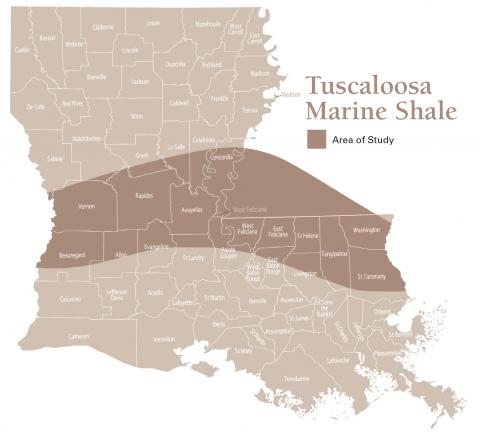The College of Engineering is excited to announce that Richard “Dan” Hereford (ME ’69) and his wife, Larry Ann, have
Petroleum Engineering Master of Science Student Studies Nearby Tuscaloosa Marine Shale
Thu, 02/13/2020 - 8:33amUL Grad School -- 02/12/2020
Asiman Saidzade is studying the elusive resources of the Tuscaloosa Marine Shale as part of his research in UL Lafayette’s Master of Science in Petroleum Engineering program.
This 8-million-acre subsurface rock formation reaches across 28 parishes in south and central Louisiana and several southwestern Mississippi counties. It is estimated to hold about 7 billion barrels of light, sweet crude oil.Tuscaloosa Marine Shale Map
The Tuscaloosa Marine Shale is also one of the most expensive places to drill in the country. It is considered an unconventional reservoir based on its geographic size and geological makeup.
Its resources are trapped within formations that require nontraditional methods of extraction, such as horizontal drilling and hydraulic fracturing.
“So far, companies have struggled to produce oil from this reservoir due to a lack of research in the area of unconventional reservoirs,” Asiman asserts.
Researchers at the University of Louisiana at Lafayette are making in-roads.
The University is home to the Tuscaloosa Marine Shale Laboratory, a multidisciplinary consortium of geologists, petroleum engineers, geophysicists and economic development experts from UL Lafayette and four other institutions.
As a member of the lab, Asiman’s research focuses on how shale rock samples react with different fluids. He works with UL Lafayette petroleum engineering faculty members Dr. Mehdi Mokhtari, who directs the consortium, and Dr. Ning Liu.
Asiman notes, “The most surprising thing for me was how much variety can a piece of rock have. You can literally see the change of layers with different minerals at an inch scale. This is very different from some conventional sandstone reservoirs, where you have little to no change over several feet.”
“Understanding the interaction between the reservoir rock and fluids is important in designing drilling and hydraulic fracturing operations,” he explains. “Ultimately, the aim is to optimize these operations using enhanced knowledge to achieve more production.”
Oil companies that can optimize their operations could not only increase production but also boost employment for the region.
Asiman’s work is funded as part of a $9.7 million grant from the U.S. Department of Energy that focuses on recovering the Tuscaloosa Marine Shale’s resources. For Asiman, who is from Azerbaijan, the opportunities provided by the grant solidified his interest in studying at UL Lafayette.
After graduating next year, he plans to further his career in petroleum engineering and continue working with unconventional reservoirs, which may prove to be the future of the oil industry.
Learn more about the Master of Science in Petroleum Engineering at UL Lafayette >
